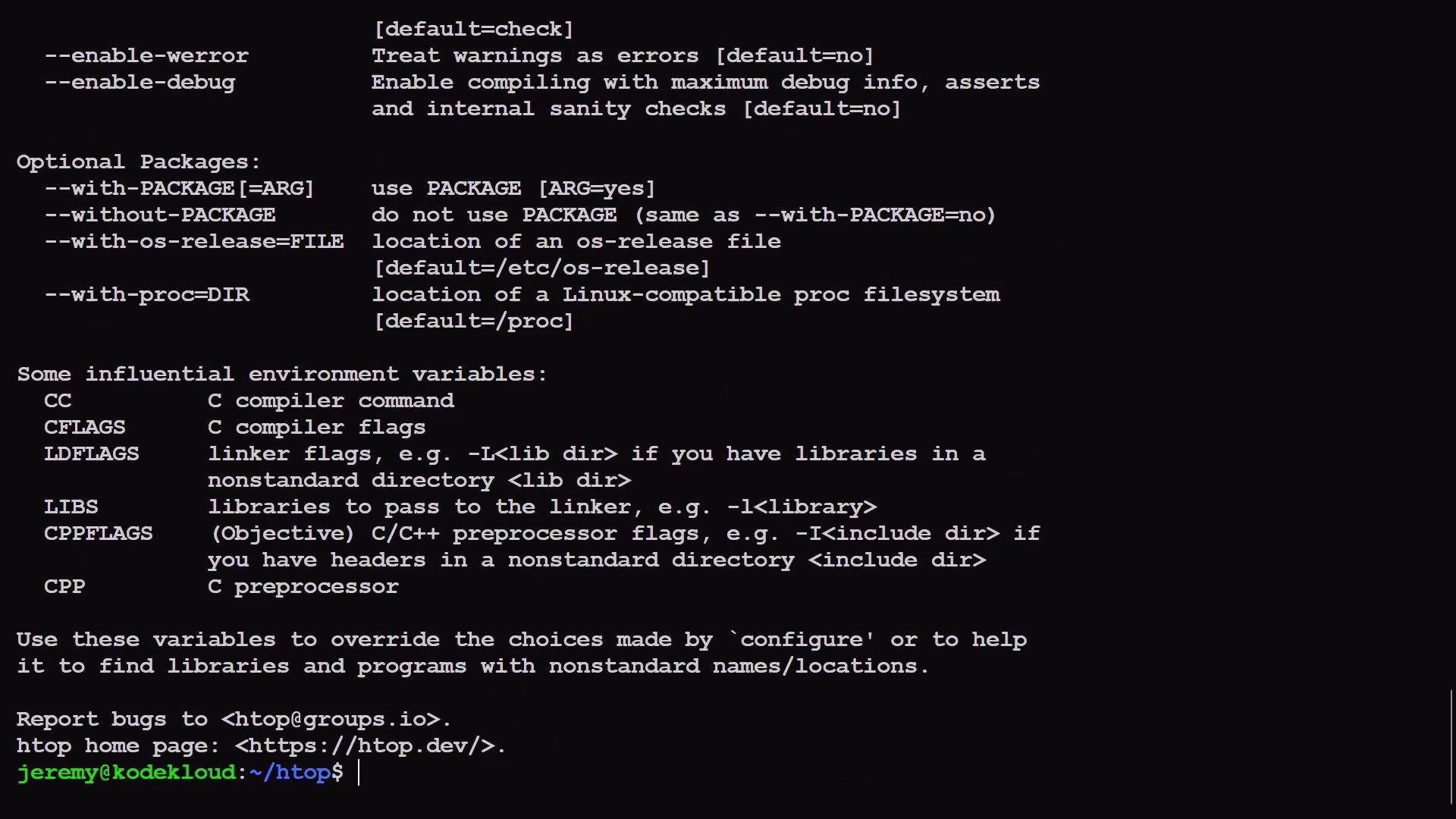Linux Foundation Certified System Administrator (LFCS)
Operations Deployment
Install Software by Compiling Source Code
In this lesson, we will explore how to install software by compiling its source code. Unlike installations from Ubuntu's repositories or third-party packages, compiling from source allows you to run the absolute latest version of an application available directly from its development repository.
When you compile software, you transform human-readable source code into an optimized binary executable that your computer can run efficiently.
Clone the Repository
Before getting started, ensure that Git is installed on your system. Most modern versions of Ubuntu and Linux come with Git pre-installed. In this example, we will clone the Git repository for an application called htop.
Run the command below to clone the repository:
git clone <GitHub-URL-of-htop-repository>
After cloning, switch to the project's directory and review its contents. You'll notice a README file that includes built-in instructions for building the project, along with other key files.

Install Dependencies
According to the README file, several libraries and compilation tools are required. One essential package is libncursesw5-dev, which is a development library, indicated by the -dev suffix. Additionally, the build-essential package installs the necessary compilation tools.
Install the required packages by running:
sudo apt install libncursesw5-dev autotools-dev autoconf automake build-essential
Tip
If you encounter dependency errors, verify that your software repositories are updated and consider running sudo apt update before installing.
Run the Autogen Script
After installing the dependencies, locate the executable script named autogen.sh (often highlighted in green). This script generates the configure file, which prepares the build configuration options for your project.
To run the autogen script, execute:
bash ./autogen.sh
The execution output should look similar to:
autoreconf: export WARNINGS=all
autoreconf: Entering directory '.'
autoreconf: configure.ac: not using Gettext
autoreconf: running: aclocal --force
autoreconf: configure.ac: tracing
autoreconf: configure.ac: creating directory build-aux
autoreconf: configure.ac: not using Libtool
autoreconf: configure.ac: not using Intltool
autoreconf: configure.ac: not using Gtkdoc
autoreconf: running: /usr/bin/autoconf --force
autoreconf: running: /usr/bin/autoheader --force
autoreconf: running: automake --add-missing --copy --force-missing
configure.ac:69: installing 'build-aux/compile'
configure.ac:23: installing 'build-aux/config.guess'
configure.ac:23: installing 'build-aux/config.sub'
configure.ac:24: installing 'build-aux/install-sh'
configure.ac:24: installing 'build-aux/missing'
Makefile.am: installing './INSTALL'
Makefile.am: installing 'build-aux/depcomp'
autoreconf: Leaving directory '.'
This generated configure script allows you to set various build options. To view all available configuration options, run:
bash
./configure --help
Running ./configure without arguments will configure the project using default settings.

Verify Configuration Requirements
Before building the project, the configuration script checks for the presence of necessary libraries and compiler support. Below is an example snippet of these checks:
checking for stdlib.h... (cached) yes
checking for string.h... (cached) yes
checking for strings.h... (cached) yes
checking for sys/param.h... yes
checking for sys/time.h... yes
checking for sys/utsname.h... yes
checking for unistd.h... (cached) yes
checking for sys/mkdev.h... no
checking for sys/sysmacros.h... yes
checking for execinfo.h... yes
checking for mbstate_t... yes
checking for mode_t... yes
checking for off_t... yes
checking for pid_t... yes
checking for size_t... yes
checking for ssize_t... yes
checking how to run the C preprocessor... gcc -E
checking for grep that handles long lines and -e... /usr/bin/grep
checking for egrep... /usr/bin/grep -E
checking for uid_t in sys/types.h... yes
checking for uint8_t... yes
checking for uint16_t... yes
checking for uint32_t... yes
checking for uint64_t... yes
checking for alloc_size... yes
checking for access... yes
checking for nonnull... yes
checking for NaN support... yes
checking for library containing ceil... |
Once all checks pass, you are ready to compile the application using make.
Compile the Application
The make command compiles the source code into an executable binary. To start the compilation process, run:
make
If you wish to see a list of all available make targets (such as clean, install, and uninstall), type make followed by a space and press the Tab key twice. These common targets help in managing build artifacts and installation processes.
For example, if the build process fails or you need to start from a clean state, you can run:
make clean
After successfully running make, the htop binary is compiled in the current directory.
Run the Compiled Application
After compilation, you can run the newly created htop executable directly from the current directory:
./htop
Upon running htop, you should see an interface similar to the following:
Main I/O
PID USER PR NI VIRT RES SHR S CPU% MEM% TIME+ Command
13535 jeremy 20 0 15120 6956 4992 S 2.0 0.1 0:06.53 sshd: jeremy@pts/0
19840 jeremy 20 0 8000 4224 3456 R 1.3 0.1 0:00.04 /htop
24200 root 20 0 58560 4200 23304 S 0.7 0.3 0:13.96 /usr/lib/systemd/systemd-journald
...
Press Q to quit the application interface.
Install the Binary System-wide
Typing the full path to run the executable each time can be cumbersome. To streamline the process, you can install the application system-wide. This action moves the htop binary into a directory included in your system's PATH (typically /usr/local/bin), allowing you to run it from any location.
Install htop system-wide by executing:
sudo make install
Now, you can simply type:
htop
For example, navigate to your home directory and run:
cd ~
htop
Because /usr/local/bin is in the default PATH for Ubuntu, you no longer need to specify the full path to launch the application.
SEO Tip
Compiling software from source can provide enhanced performance and access to the latest features. Always refer to the project's README for specific build instructions and troubleshooting tips.
Conclusion
In this lesson, we covered the process of compiling and installing software from source code. The steps included:
- Cloning the repository
- Installing necessary dependencies
- Generating configuration scripts via
autogen.sh - Verifying configuration requirements
- Compiling the project using
make - Running and installing the binary system-wide
By compiling from source, you ensure that you are running the most recent version of the application. Happy compiling, and see you in the next lesson!
htop
Watch Video
Watch video content
Practice Lab
Practice lab